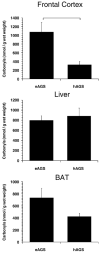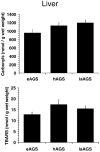Physiological oxidative stress after arousal from hibernation in Arctic ground squirrel
- PMID: 19233307
- PMCID: PMC2784939
- DOI: 10.1016/j.cbpa.2009.02.016
Physiological oxidative stress after arousal from hibernation in Arctic ground squirrel
Abstract
Hibernation in Arctic ground squirrels (AGS), Spermophilus parryii, is characterized by a profound decrease in oxygen consumption and metabolic demand during torpor that is punctuated by periodic rewarming episodes, during which oxygen consumption increases dramatically. The extreme physiology of torpor or the surge in oxygen consumption during arousal may increase production of reactive oxygen species, making hibernation an injurious process for AGS. To determine if AGS tissues experience cellular stress during rewarming, we measured carbonyl proteins, lipid peroxide end products and percent oxidized glutathione in brown adipose tissue (BAT) and liver of torpid, hibernating (hAGS), late arousal (laAGS), and cold-adapted, euthermic AGS (eAGS). In BAT carbonyl proteins and lipid peroxide end products were higher in eAGS and laAGS than in hAGS. By contrast, in liver, no significant difference in carbonyl proteins was observed. In another group of animals, comparison of carbonyl proteins and percent oxidized glutathione in frontal cortex, liver, and BAT of eAGS and hAGS showed no evidence of oxidative stress associated with torpor. These results indicate that increased thermogenesis associated with arousal AGS results in tissue specific oxidative stress in BAT but not in liver. Moreover, torpor per se is largely devoid of oxidative stress, likely due to suppression of oxidative metabolism.
Figures







Similar articles
-
Absence of cellular stress in brain after hypoxia induced by arousal from hibernation in Arctic ground squirrels.Am J Physiol Regul Integr Comp Physiol. 2005 Nov;289(5):R1297-306. doi: 10.1152/ajpregu.00260.2005. Epub 2005 Jun 23. Am J Physiol Regul Integr Comp Physiol. 2005. PMID: 15976308
-
Controllable oxidative stress and tissue specificity in major tissues during the torpor-arousal cycle in hibernating Daurian ground squirrels.Open Biol. 2018 Oct 10;8(10):180068. doi: 10.1098/rsob.180068. Open Biol. 2018. PMID: 30305429 Free PMC article.
-
Hibernation induces oxidative stress and activation of NK-kappaB in ground squirrel intestine.J Comp Physiol B. 2000 Nov;170(7):551-9. doi: 10.1007/s003600000135. J Comp Physiol B. 2000. PMID: 11128446
-
Arousal from Torpor Increases Oxidative Damage in the Hibernating Thirteen-Lined Ground Squirrel (Ictidomys tridecemlineatus).Physiol Biochem Zool. 2022 May-Jun;95(3):229-238. doi: 10.1086/719931. Physiol Biochem Zool. 2022. PMID: 35443147
-
Inhibition of NMDA-type glutamate receptors induces arousal from torpor in hibernating arctic ground squirrels (Urocitellus parryii).J Neurochem. 2012 Sep;122(5):934-40. doi: 10.1111/j.1471-4159.2012.07832.x. Epub 2012 Jul 11. J Neurochem. 2012. PMID: 22697356 Free PMC article.
Cited by
-
Diet-independent remodeling of cellular membranes precedes seasonally changing body temperature in a hibernator.PLoS One. 2011 Apr 13;6(4):e18641. doi: 10.1371/journal.pone.0018641. PLoS One. 2011. PMID: 21533242 Free PMC article.
-
Predictive and reactive changes in antioxidant defence system in a heterothermic rodent.J Comp Physiol B. 2020 Jul;190(4):479-492. doi: 10.1007/s00360-020-01280-7. Epub 2020 May 20. J Comp Physiol B. 2020. PMID: 32435827 Free PMC article.
-
Anti-apoptotic signaling as a cytoprotective mechanism in mammalian hibernation.PeerJ. 2013 Feb 12;1:e29. doi: 10.7717/peerj.29. Print 2013. PeerJ. 2013. PMID: 23638364 Free PMC article.
-
Molecular Liver Fingerprint Reflects the Seasonal Physiology of the Grey Mouse Lemur (Microcebus murinus) during Winter.Int J Mol Sci. 2022 Apr 12;23(8):4254. doi: 10.3390/ijms23084254. Int J Mol Sci. 2022. PMID: 35457071 Free PMC article.
-
Diapause induces functional axonal regeneration after necrotic insult in C. elegans.PLoS Genet. 2019 Jan 14;15(1):e1007863. doi: 10.1371/journal.pgen.1007863. eCollection 2019 Jan. PLoS Genet. 2019. PMID: 30640919 Free PMC article.
References
-
- Bickler PE, Buck LT. Hypoxia tolerance in reptiles, amphibians, and fishes: life with variable oxygen availability. Annu Rev Physiol. 2007;69:145–170. - PubMed
-
- Blagojevic D, Buzadzic B, Korac B, Saicic ZS, Radojicic R, Spasic MB, Petrovic VM. Seasonal changes in the antioxidative defense in ground squirrels (Citellus citellus): possible role of GSH-Px. J Environ Pathol Toxicol Oncol. 1998;17:241–250. - PubMed
-
- Boyer BB, Barnes BM, Lowell BB, Grujic D. Differential regulation of uncoupling protein gene homologues in multiple tissues of hibernating ground squirrels. Am J Physiol. 1998;275:R1232–1238. - PubMed
-
- Brand MD, Esteves TC. Physiological functions of the mitochondrial uncoupling proteins UCP2 and UCP3. Cell Metab. 2005;2:85–93. - PubMed
-
- Buzadzic B, Spasic M, Saicic ZS, Radojicic R, Petrovic VM, Halliwell B. Antioxidant defenses in the ground squirrel Citellus citellus. 2. The effect of hibernation. Free Radic Biol Med. 1990;9:407–413. - PubMed
Publication types
MeSH terms
Grants and funding
LinkOut - more resources
Full Text Sources

